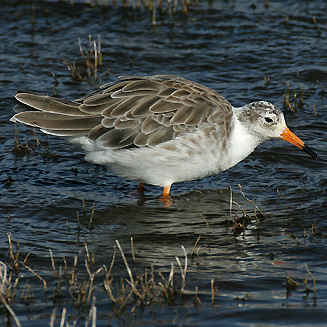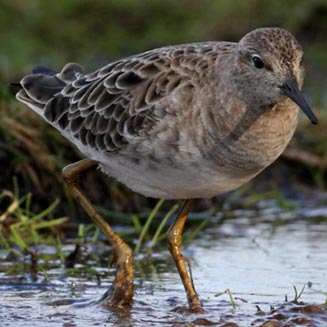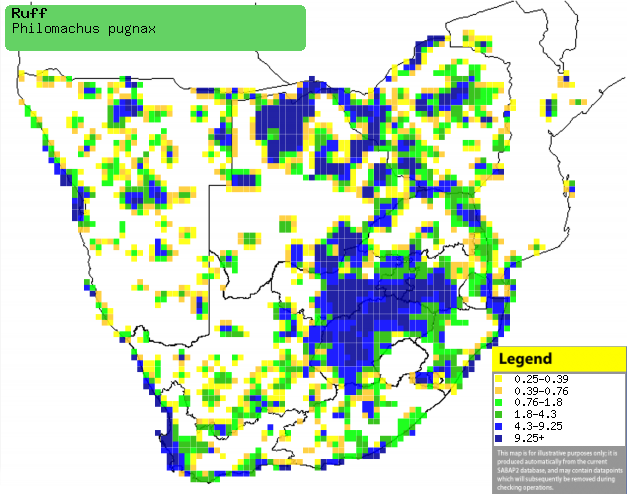|
Philomachus pugnax (Ruff, Reeve
(female)
Kemphaan [Afrikaans]; Koe-koe-lemao (generic term for
sandpiper), Seealemabopo-se-maroboko [South Sotho]; Kemphaan [Dutch]; Combattant
varié [French]; Kampfläufer [German]; Combatente [Portuguese]
Life
> Eukaryotes >
Opisthokonta
> Metazoa (animals) >
Bilateria >
Deuterostomia > Chordata >
Craniata > Vertebrata (vertebrates) > Gnathostomata (jawed
vertebrates) > Teleostomi (teleost fish) > Osteichthyes (bony fish) > Class:
Sarcopterygii (lobe-finned
fish) > Stegocephalia (terrestrial
vertebrates) > Tetrapoda
(four-legged vertebrates) > Reptiliomorpha > Amniota >
Reptilia (reptiles) >
Romeriida > Diapsida > Archosauromorpha > Archosauria >
Dinosauria
(dinosaurs) > Saurischia > Theropoda (bipedal predatory dinosaurs) >
Coelurosauria > Maniraptora > Aves
(birds) >
Order: Charadriiformes > Family: Scolopacidae
 |
 |
|
Ruff male (alternative form), Veldrif, Western Cape. [photo
Jim Scarff
©] |
Ruff male in non-breeding plumage, Britain. [photo
Martin Goodey
©] |
Distribution and habitat
Breeds in broad strip of land from The Netherlands across
Northern Europe to Siberia, heading south in the non-breeding season to India,
southern Arabia and much of sub-Saharan Africa, including southern Africa. Here
it is common in patches across the region, largely excluding Mozambique,
generally preferring damp meadows with shallow pools and ditches. It also occurs
at salt-marshes, muddy estuaries, temporary pans, dams, vleis, sewage works,
salt works and saline wetlands, occasionally moving to cultivated land and the
open coast.
|
 |
|
Distribution of Ruff in southern Africa,
based on statistical smoothing of the records from first SA Bird Atlas
Project (©
Animal Demography unit, University of
Cape Town; smoothing by Birgit Erni and Francesca Little). Colours range
from dark blue (most common) through to yellow (least common).
See here for the latest distribution
from the SABAP2. |
Predators and parasites
Movements and migrations
Its breeding population in Siberia go on the
longest migration of any terrestrial bird, as they first leave their
colonies in July before heading west to the Black and Caspian Seas,
then heading south to southern Africa, a total journey of
approximately 16 000km . It arrives in southern Africa in August,
after which adult males leave first in January, followed by immature
males in February and finally adult and immature females in April
and May. A very small proportion of them stay over winter in the
region, usually because of injury.
Food
It mainly eats invertebrates, such as insects and
crustaceans, doing most of its foraging by wading through shallow water or mud,
regularly probing in search of prey or grabbing small insects from the surface. The following food items have been recorded
in its diet:
- Invertebrates
- insects
-
spiders
- annelid worms
- small molluscs
- crustaceans
- Vertebrates
- fish and their fry
- small frogs
- Plant matter, such as seeds
Threats
Not threatened, although destruction of grassland at its
breeding grounds is cause for concern.
References
-
Hockey PAR, Dean WRJ and Ryan PG 2005. Roberts
- Birds of southern Africa, VIIth ed. The Trustees of the John Voelcker
Bird Book Fund, Cape Town.
|
